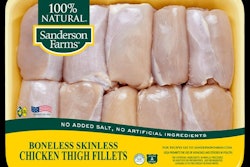
As Sanderson Farms released its financial results for the 2019 fiscal year, the company’s CEO spoke optimistically about the present state of the company, while highlighting five market trends that Sanderson Farms will pay particular attention to in 2020.
“We start the new year in good shape. Chicken markets are improving, feed costs are relatively flat, our balance sheet is strong, we start fiscal 2020 with little debt, and the company is well-positioned to continue our growth strategy in the future,” Sanderson Farms chairman and CEO Joe F. Sanderson Jr. said during a quarterly earnings call on December 19.
During the call, Sanderson identified and provided commentary on the market trends to watch in 2020.
1. South American crop production
The success of grain harvests in South America will impact grain prices and feed costs. Sanderson said, “As of today, the corn and soy crops in Brazil and the rest of South America are progressing normally.”
2. Planting intentions in the United States
The U.S. Department of Agriculture (USDA) will release its planting intentions report in March. At that time, the company will get a clearer picture on feed ingredient supplies in the future.
“Most everyone believes corn acres will increase in 2020, while soybean acres will decrease,” he said.
3. Chicken production numbers
Sanderson cited USDA estimates that predict the U.S. poultry industry will produce about 3.2% more pounds of chicken during the 2020 calendar year than it did in 2019.
“Looking at egg sets, chick placements, pullet placements and the size of the hen flock, we believe the USDA’s estimate is reasonable,” Sanderson said. “Several facilities and expansions have been completed, including our Tyler, Texas, complex, and we understand from publicly available information, that a couple more expansion projects have either started operations or are near completion.”
“Whether or not and to what extent that new production exceeds demand for chicken remains to be seen. What we will do is continue to execute our growth strategy, continue to look for a site for our next plant, and let the markets take care of themselves.”
4. Chicken markets
In 2019, there was less feature activity for chicken, but Sanderson is encouraged by the current chicken sandwich feud among quick service restaurants.
He also provided an assessment of current market prices.
“Market prices for boneless breast meat produced at our big bird plants fo the foodservice market have moved counter-seasonally higher over the past few weeks. The same is true for dark meat prices,” Sanderson said.
5. Impact of African swine fever
As Asia, and to a lesser degree, Europe, have dealt with pig losses due to African swine fever (ASF), it has led to a reduced supply of pork and animal protein in general, affecting protein markets. The poultry industry has kept a close eye on the situation throughout 2019, and will continue to do so in 2020.
“While there remain conflicting reports on the exact number of hogs lost to the disease in China and other Asian countries, the fact that the world is facing an unprecedented protein deficit over the short term is real,” Sanderson said. “Exactly what the impact on chicken markets (will be) is unknowable. However, we are very encouraged that we are once again eligible to ship product to China, and expect a material benefit from the open market.”

















